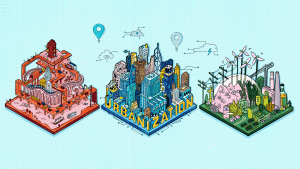Sustainable Urbanization: Green Mobility Gamification and Eco-friendly Solutions
Introduction
Urbanization, characterized by the concentration of populations in urban areas, poses significant environmental challenges. These include land degradation, air and water pollution, and loss of natural habitats. However, sustainable urbanization strategies like green mobility gamification, green infrastructure, and renewable energy can indeed help create eco-friendly cities. So in this article you can discover sustainable urbanization solutions.
The Impact of Urbanization on the Environment
-
Land Degradation: Firstly, urban expansion often leads to the conversion of agricultural and natural lands into built-up areas, contributing to soil degradation, habitat fragmentation, and loss of biodiversity (Seto et al., 2012).
-
Air Pollution: Secondly, increased emissions from transportation, industries, and energy consumption in urban areas result in air pollution, causing millions of premature deaths annually (WHO, 2018).
-
Water Pollution: Lastly, high population density in cities puts pressure on water resources, leading to pollution from untreated sewage, industrial waste, and storm water runoff, which threatens aquatic ecosystems and human health (Grimm et al., 2008).
Sustainable Urbanization: Strategies and Solutions
-
Green Mobility Gamification: Gamification principles can be applied to green mobility to incentivize sustainable transportation choices. The Differdange City Hall in collaboration with Morfin.io, gamification platform and app, created a unique way to motivate the city hall employees to choose commuting to work everyday by walking, running, cycling or by public transport.
-
Green Infrastructure: Implementing green infrastructure, such as green roofs, rain gardens, and permeable pavements, helps manage storm water, reduce the urban heat island effect, and improve air quality (EPA, 2021).
-
Sustainable Urban Planning: Integrating sustainability principles into urban planning promotes compact, mixed-use developments, accessible public transportation, and well-connected pedestrian and cycling networks to reduce pollution and conserve resources (Farr, 2008).
-
Renewable Energy: Transitioning to renewable energy sources like solar and wind can significantly reduce greenhouse gas emissions associated with electricity generation. Cities can invest in renewable energy projects, promote energy efficiency, and encourage electric vehicle adoption (ICLEI, 2021).
Conclusion
Sustainable urbanization strategies, including green mobility gamification, green infrastructure, sustainable urban planning, renewable energy, waste management, nature-based solutions, and smart city technologies, can mitigate the environmental impacts of urbanization. Undeniably by embracing these eco-friendly solutions, cities can create a greener, healthier future for urban dwellers worldwide.
References:
EPA. (2021). Green Infrastructure. United States Environmental Protection Agency. Retrieved from https://www.epa.gov/green-infrastructure
Farr, D. (2008). Sustainable Urbanism: Urban Design with Nature. Wiley.
Grimm, N. B., Faeth, S. H., Golubiewski, N. E., Redman, C. L., Wu, J., Bai, X., & Briggs, J. M. (2008). Global Change and the Ecology of Cities. Science, 319(5864), 756–760.
Seto, K. C., Güneralp, B., & Hutyra, L. R. (2012). Global forecasts of urban expansion to 2030 and direct impacts on biodiversity and carbon pools. Proceedings of the National Academy of Sciences, 109(40), 16083–16088.
World Health Organization. (2018). Ambient (outdoor) air quality and health. Retrieved from https://www.who.int/news-room/fact-sheets/detail/ambient-(outdoor)-air-quality-and-health


